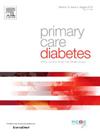Pin-prick (Medipin) assessment for neuropathy in diabetes: Prospective screening study in primary care
IF 2.6
4区 医学
Q3 ENDOCRINOLOGY & METABOLISM
引用次数: 0
Abstract
Aims
Diabetic patients are at elevated risk of neuropathy; early detection is desirable to minimise the risk of complications. The Medipin pin-prick device was appraised as a screening tool for diabetic neuropathy.
Methods
Prospective cross-sectional comparative screening study in primary care setting, involving 389 participants with type 2 diabetes mellitus. The Medipin pin-prick method, involving dorsal application on the hallux of both feet, was compared to 10 g monofilament testing.
Results
The ternary and semi-quantitative approach for scoring Medipin pin-prick sensation give very similar results (Spearman rho 0.67, P < 0.001). A total of 59 % patients had no signs of neuropathy (sharp sensation), 38 % reported impaired sensation (dull sensation), and an absence of sensation occurred in 3 % of patients. For the monofilament dorsal method, the figures were 79 % no neuropathy, 14 % elevated risk, and 7 % neuropathy respectively, and with the monofilament plantar method 87 % of patients had no neuropathy and 13 % did. Correlation analyses showed that taller patients and those with existing neuropathic pain are at very modest increased risk of neuropathy.
Conclusions
The Medipin pin-prick device can identify diabetic neuropathy and detects (first signs of) neuropathy in relatively more patients than 10 g monofilament testing. The differential targeting of nerve types, namely predominant small (Medipin) versus large (monofilament) fibre, likely underpins the difference in outcomes.
糖尿病神经病变的针刺(Medipin)评估:基层医疗机构的前瞻性筛查研究。
目的:糖尿病患者罹患神经病变的风险较高;为了将并发症的风险降至最低,最好能及早发现。我们对 Medipin 针刺器作为糖尿病神经病变筛查工具进行了评估:方法:在基层医疗机构开展前瞻性横断面比较筛查研究,共有 389 名 2 型糖尿病患者参与。结果:三元和半定量分析结果表明,Medipin 针刺法和 10 g 单丝检测法均可用于糖尿病神经病变的筛查:三元法和半定量法对 Medipin 针刺感觉的评分结果非常相似(Spearman rho 0.67,P < 0.001)。共有 59% 的患者没有神经病变迹象(感觉敏锐),38% 的患者感觉受损(感觉迟钝),3% 的患者没有感觉。采用单丝背侧法时,79%的患者没有神经病变,14%的患者风险升高,7%的患者出现神经病变;采用单丝跖侧法时,87%的患者没有神经病变,13%的患者出现神经病变。相关分析表明,身高较高的患者和已有神经病理性疼痛的患者发生神经病变的风险略有增加:结论:与 10 克单丝测试相比,Medipin 针刺设备能识别糖尿病神经病变,并能检测到更多患者的神经病变(首发症状)。不同的神经类型,即主要的小纤维(Medipin)和大纤维(单丝),可能是结果差异的基础。
本文章由计算机程序翻译,如有差异,请以英文原文为准。
求助全文
约1分钟内获得全文
求助全文
来源期刊

Primary Care Diabetes
ENDOCRINOLOGY & METABOLISM-PRIMARY HEALTH CARE
CiteScore
5.00
自引率
3.40%
发文量
134
审稿时长
47 days
期刊介绍:
The journal publishes original research articles and high quality reviews in the fields of clinical care, diabetes education, nutrition, health services, psychosocial research and epidemiology and other areas as far as is relevant for diabetology in a primary-care setting. The purpose of the journal is to encourage interdisciplinary research and discussion between all those who are involved in primary diabetes care on an international level. The Journal also publishes news and articles concerning the policies and activities of Primary Care Diabetes Europe and reflects the society''s aim of improving the care for people with diabetes mellitus within the primary-care setting.
 求助内容:
求助内容: 应助结果提醒方式:
应助结果提醒方式:


